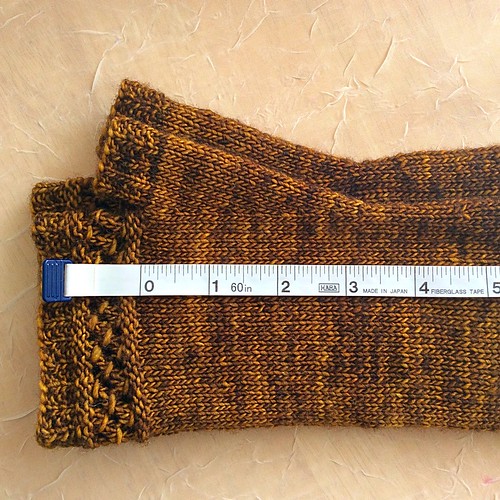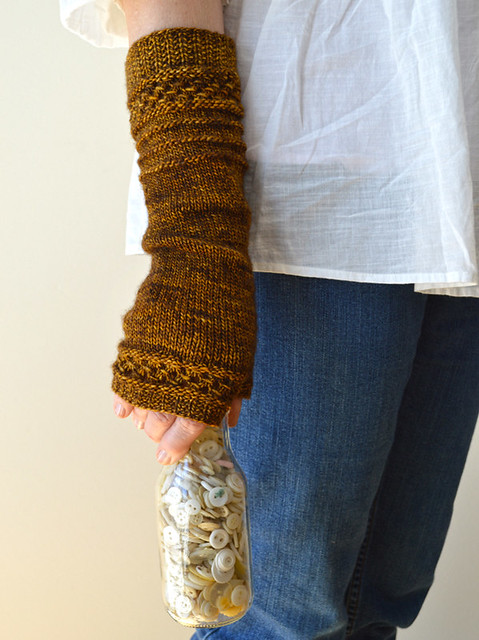A friend of mine is knitting a pair of On the Other Hand mitts for herself. An experienced knitter, she knows the importance of gauge and took the time to knit a swatch and adjust her needle size to get gauge. Her first mitt came out great—but the second one? Too big and too long!
Pattern: On the Other Hand, by Bonnie Sennott
Yarn: Skeinny Dipping Merino Single in Brown Butter
How could that happen? Well, although the same knitter knit the same size mitt with the same needles and yarn, that same knitter was on serious cold meds while knitting the second mitt, and apparently she knit at a much looser gauge! This doesn't surprise me. I know that if I am feeling relaxed and at ease while knitting, my gauge tends to loosen up, but if I'm tense and worried it can easily tighten up.
You might be wondering—does gauge matter for a small item like a fingerless mitt? The answer is: yes! Being off just a half inch on a mitt can make it too big or too small. And I find that mitts tend to stretch out after several wearings, so I would rather they not fit loosely when I first finish them.
Here's just a little math to demonstrate why gauge matters for a pair of mitts. For On the Other Hand, the gauge on the larger needles (used for the stockinette part of the mitt) is 27 stitches and 40 rows = 4 inches/10cm. So, the stitch gauge is 6.75 stitches per inch. After the thumb gusset, the larger size mitt has 48 stitches around the palm. Those 48 stitches divided by 6.75 stitches per inch result in a palm circumference of about 7 inches (7.11, to be exact). If your gauge is looser, say 25 stitches over 4 inches (or 6.25 per inch), those same 48 stitches will result in a palm circumference of 7.68 inches. That might be bigger than you want (and it's certainly bigger than what the pattern states).
What about row gauge? It matters too! Again, a bit of math to demonstrate: The thumb gusset on the larger size is worked over 32 rows. At a row gauge of 10 rows per inch (32 divided by 10), the gusset will measure about 3.25 inches. But if your row gauge is loose—say 9 rows per inch—your gusset will measure 3.55 inches. That still might fit you OK, but it might be rather long. And if your row gauge is too loose throughout the entire mitt, it will be longer than anticipated.
Swatching first—and blocking your swatch as you will block the finished item—is always a good idea. But if you're the sort of knitter who wants to plunge right in when knitting small things like hats or socks or mitts (or maybe you did make a swatch, but then your gauge on the actual project got all loosey-goosey), then maybe the road to good fit and happiness is best found by simply adjusting your outlook. To me, knitting 4-5 inches of a mitt that's 48 stitches around is not much more work than knitting a gauge swatch. So I often cast on with the size needle I know from experience is likely to be best, and then I try on frequently as I go. I am always prepared to rip back/start over/change needles if things go awry.
Basically, I swatch when I feel it's a good idea—and if I don't swatch, I take the attitude that starting small projects over (or even the sleeve of a sweater) isn't much of a setback.
What's your approach to swatching? Do you or don't you? Do you mind ripping back and starting over?





1 comment:
For a sweater, I swatch and block. For scarf or shawl, it depend, I start with the designer recommendations but I'm ready to unravel if I don't like the result.
Post a Comment